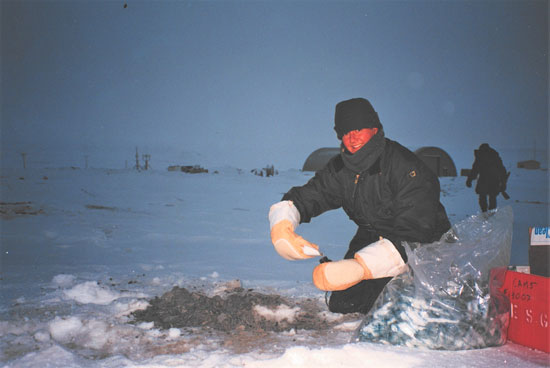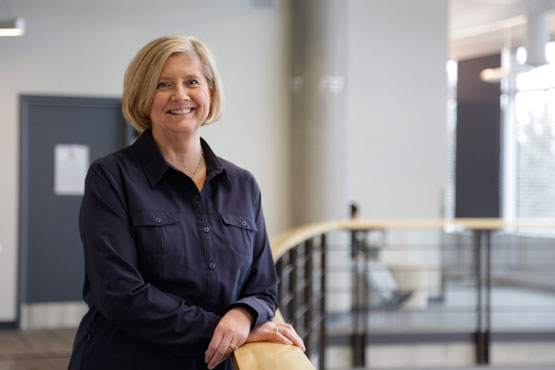February 13, 2024
When given the chance to serve her country and make a difference in the world, time and time again, Marie-Pierre Raymond has enthusiastically said yes.
Raymond is about to depart on a six-month assignment as a civilian science advisor to the Canadian Defence Attaché at the Canadian Embassy in Kyiv, Ukraine, where she will act as a liaison between the Ukrainian military, Defence Research Development Canada (DRDC), other government organizations and Canadian innovators.
“I want to have a positive impact and bring Canadian innovation into the hands of Ukrainians. I want Ukraine and the world to see what Canada has to offer,” Raymond says.
Raymond’s career has made her uniquely qualified to fill this role, beginning with her education in chemistry and chemical engineering. She served 12 years in the Reserves and 27 years in the Canadian Armed Forces (CAF), where she conducted environmental work, which brought her to the Arctic, Turkey, and East Timor.

Marie-Pierre Raymond conducted environmental work during her 27-year career with the Canadian Armed Forces.
Innovation
Raymond’s last posting in uniform was as a senior military advisor at Defence Research and Development Canada (DRDC). When she retired from the military, Raymond transferred into a new role as a defence scientist and innovation challenge manager with the Innovation for Defence Excellence and Security (IDEaS) program.
“Having a background in uniform has been my superpower.”
As a challenge manager, Raymond works as the liaison between the CAF and the Canadian innovators who are working to develop solutions to the military’s hardest problems.
Raymond sees innovation as a team effort, so she begins with challenge scoping sessions that bring together the CAF stakeholders who submitted their innovation requirements. In these sessions, they define the boundaries, goals and constraints of their problem and then identify the gaps.
“The problem needs to be scoped with the soldiers to ensure the results meet their needs,” Raymond says. “Problem formulation is the core of innovation. We need to correctly frame the problem to find the right solution for the end-users. To find the right solution it is important to understand the root cause of a problem, not the symptoms.”
The challenge manager role continues through the IDEaS innovation pipeline, with Raymond acting as a mentor, support and liaison between innovators, the IDEaS program and the CAF end-users.
“Having a military background has been my superpower as a challenge manager,” Raymond jokes.
As a former CAF member and a scientist by training, Raymond acts as a bridge to ensure innovation is tailored to the needs of the CAF by helping the innovators understand the military context and culture. Now she’ll be applying those same skills in the Ukraine.

Marie-Pierre Raymond is bringing her experience as a challenge manager for the Innovation for Defence Excellence and Security (IDEaS) program to a new role as a science advisor to the Canadian Defence Attaché at the Canadian Embassy in Kyiv, Ukraine.
Raymond has worked on a number of interesting IDEaS projects, some of which were selected for longer-term evaluation, called a Test Drive. For example, Sapper Labs developed a cyber attribution solution to enable the prosecution of sophisticated cyber threat actors. Currently Canadian Forces Intelligence Command (CFINTCOM) is testing Ecopia’s artificial intelligence engine for the detection and identification of objects of interest, and Canadian Special Operations Forces Command (CANSOFCOM) and the Royal Canadian Air Force (RCAF) are testing TerraSense Analytics’ Multimodal Input Surveillance & Tracking (MIST) technology, which is an AI solution to monitor and interpret high volumes of data from multiple sensors. Raymond will be using her experience with IDEaS Test Drives to help connect Ukrainians with Canadian innovators that can also meet their needs.
“If you want to win the battle, you need intelligence. The more intelligence you have, the smaller military and resources you need to keep ahead of the adversaries,” Raymond says.
Filling the gap
DRDC has signed a three-year memorandum of understanding to provide scientific advisors for Op UNIFIER, who will rotate in on six-month assignments at the Canadian Embassy in Ukraine.
“The position is about helping the Ukrainian military and capturing their needs, as well as acting as a liaison back to the Canadian innovation ecosystem and Defence Research and Development Canada to determine where Canada could fill some of their operational gaps,” Raymond says.
For example, the IDEaS program is looking at developing an accelerated challenge on mine clearance technology, in consultation with the Ukrainian military. At a recent mission analysis event, which fed into the challenge, Canadian innovators talked with Ukrainian military members who have current real-world experience fighting around minefields.
“We are engaging Canadian innovators to see if there are new ways to detect and clear minefields, while preventing harm to demining personnel and the civilian population,” Raymond explains, adding that she will be acting as an adviser and facilitator between Canadian industry and Ukrainian defence representatives.
